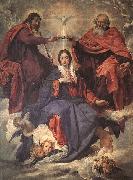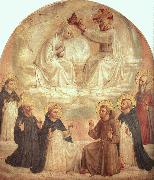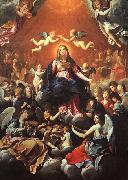
Oil On
Canvas, Real Flavor of Old Masters
|
Diego Velazquez
|
|||
|
|
|||
| Spanish Baroque Era Painter, 1599-1660 Spanish painter. He was one of the most important European artists of the 17th century, spending his career from 1623 in the service of Philip IV of Spain. His early canvases comprised bodegones and religious paintings, but as a court artist he was largely occupied in executing portraits, while also producing some historical, mythological and further religious works. His painting was deeply affected by the work of Rubens and by Venetian artists, especially Titian, as well as by the experience of two trips (1629-31 and 1649-51) to Italy. Under these joint influences he developed a uniquely personal style characterized by very loose, expressive brushwork. Although he had no immediate followers, he was greatly admired by such later painters as Goya and Manet | |||
|
|
|||
|
|
The Coronation of the Virgin Diego Velazquez32.jpg Painting ID:: 763 Visit European Gallery |
1641-44 Museo del Prado, Madrid | |
Height Width |
INS/CM |
||
|
X |
|
||
|
|
|||
|
Lorenzo Monaco
|
|||
|
|
|||
| Italian c1370-c1424 Lorenzo Monaco Gallery was a Florentine painter. He joined the Camaldolese monastery of Santa Maria degli Angeli in Florence in 1391, but he left monastic life before making a lifetime commitment. Despite this fact, he has traditionally been called "Lawrence the Monk." His work shows the influence of the International Gothic style of the late fourteenth century, as well as that of the Sienese school. | |||
|
|
|||
|
|
The Coronation of the Virgin Lorenzo Monaco1.jpg Painting ID:: 2606 Visit European Gallery |
1414 Galleria degli Uffizi, Florence | |
Height Width |
INS/CM |
||
|
X |
|
||
|
|
|||
|
Fra Angelico
|
|||
|
|
|||
| Fra Angelico Galleries b.c. 1400, Vicchio, Florence d.Feb. 18, 1455, Rome Fra Angelico (c. 1395 ?C February 18, 1455), born Guido di Pietro, was an Early Italian Renaissance painter, referred to in Vasari's Lives of the Artists as having "a rare and perfect talent". Known in Italy as il Beato Angelico, he was known to his contemporaries as Fra Giovanni da Fiesole (Brother John from Fiesole). In Giorgio Vasari's Lives of the Artists, written prior to 1555, he was already known as Fra Giovanni Angelico (Brother Giovanni the Angelic One). Within his lifetime or shortly thereafter he was also called Il Beato (the Blessed), in reference to his skills in painting religious subjects. In 1982 Pope John Paul II conferred beatification, thereby making this title official. Fiesole is sometimes misinterpreted as being part of his formal name, but it was merely the name of the town where he took his vows, used by contemporaries to separate him from other Fra Giovannis. He is listed in the Roman Martyrology as Beatus Ioannes Faesulanus, cognomento Angelicus??"Blessed Giovanni of Fiesole, nicknamed Angelico". Fra Angelico was working at a time when the style of painting was in a state of change. This process of change had begun a hundred years previous with the works of Giotto and several of his contemporaries, notably Giusto de' Menabuoi, both of whom had created their major works in Padua, although Giotto was trained in Florence by the great Gothic artist, Cimabue, and painted a fresco cycle of St Francis in the Bardi Chapel in Santa Croce. Giotto had many enthusiastic followers, who imitated his style in fresco, some of them, notably the Lorenzetti, achieving great success. | |||
|
|
|||
|
|
The Coronation of the Virgin Fra Angelico14.jpg Painting ID:: 3260 Visit European Gallery |
1440-41 Museo di San Marco, Florence | |
Height Width |
INS/CM |
||
|
X |
|
||
|
|
|||
|
Guido Reni
|
|||
|
|
|||
| 1575-1642 Italian Guido Reni Galleries Born in Bologna into a family of musicians, Guido Reni was the son of Daniele Reni and Ginevra de?? Pozzi. As a child of nine, he was apprenticed under the Bolognese studio of Denis Calvaert. Soon after, he was joined in that studio by Albani and Domenichino. He may also have trained with a painter by the name of Ferrantini. When Reni was about twenty years old, the three Calvaert pupils migrated to the rising rival studio, named Accademia degli Incamminati (Academy of the "newly embarked", or progressives), led by Lodovico Carracci. They went on to form the nucleus of a prolific and successful school of Bolognese painters who followed Annibale Carracci to Rome. Like many other Bolognese painters, Reni's painting was thematic and eclectic in style. By late 1601, Reni and Albani had moved to Rome to work with the teams led by Annibale Carracci in fresco decoration of the Farnese Palace. During 1601-1604, his main patron was cardinal Sfondrato. By 1604-1605, he received an independent commission for an altarpiece of the Crucifixion of St. Peter. After a few year sojourn in Bologna, he returned to Rome to become one of the premier painters during the papacy of Paul V (Borghese). From 1607-1614, he was one of the painters patronized by Borghese. Abduction of Deianira, 1620-1621.Reni's frescoed ceiling of the large central hall of garden palace, Casino dell'Aurora located in the grounds of the Palazzo Pallavicini-Rospigliosi, is considered his masterpiece. The casino was originally a pavilion commissioned by Cardinal Scipione Borghese; the rear portion overlooks the Piazza Montecavallo and Palazzo del Quirinale. The massive fresco is framed in quadri riportati and depicts Apollo in his Chariot preceded by Dawn (Aurora) bringing light to the world. The work is restrained in classicism, copying poses from Roman Sarcophagi, and showing far more simplicity and restraint than Carracci's riotous Triumph of Bacchus and Ariadne[5] in the Farnese. Reni in this painting is allies himself more with the sterner Cavaliere d'Arpino,Lanfranco, and Albani "School" of mytho-historic painting, and less with the more crowded frescoes characteristic of Pietro da Cortona. There is little concession to perspective, and the vibrantly colored style is antithetical to the tenebrism of Caravaggio's followers. Payments showed that he was paid in 247 scudi and 54 baiocchi upon completion on 24 September 1616. He also frescoed in Paoline Chapel of Santa Maria Maggiore in Rome as well as the Aldobrandini wings of the Vatican. According to rumor, the pontifical chapel of Montecavallo (Chapel of the Annuciation) was assigned to Reni to paint. However, because he felt underpaid by the ministers, the artist left for Bologna, leaving the role of the preeminent artist in Rome to Domenichino. | |||
|
|
|||
|
|
The Coronation of the Virgin Guido Reni2.jpg Painting ID:: 3411 Visit European Gallery |
1626 Musee Bonnat, Bayonne | |
Height Width |
INS/CM |
||
|
X |
|
||
|
|
|||










